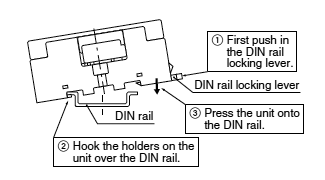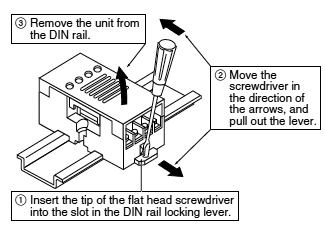[System Maintenance Notice]
Due to ongoing system maintenance, the site search and specification search functions are temporarily unavailable. We apologize for any inconvenience this may cause and appreciate your understanding.
RT-3 UNIT RELAY (PA-N relay type) /4-POINT TERMINAL (Without relay type)
Cautions For Use
1.Never install modules (relays) into this product other than those designated. Doing so will cause malfunction, breakdown, and breakdown of the connected product.
2.If a unit is dropped be sure to check its external appearance and characteristics before using it.
3.The operate and release voltage values when equipped with PA-N relays are based on the relay terminals being face down. (RT-3 Unit relay (PA-N type), 4-point Terminal)
4.Switching lifetime (PA-N relay)
This characteristic depends on the relay and is effected by coil driving circuit, load type, activation frequency, activation phase, ambient conditions and other factors.
Also, be especially careful of loads such as those listed below.
- 1.When used for AC load-operating and the operating phase is synchronous, rocking and fusing can easily occur due to contact shifting.
- 2.Frequent switching under load condition
When high frequently switched under load condition that can cause arc at the contacts, nitrogen and oxygen in the air is fused by the arc energy and HNO3 is formed. This can corrode metal materials.
Three countermeasures for these are listed here.
- 1.Incorporate an arc-extinguishing circuit.
- 2.Lower the operating frequency
- 3.Lower the ambient humidity
5.Operating environment
1.Keep the product as far way as possible from power cables, high tension equipment, power equipment, equipment with transmitting devices such as amateur radios, or equipment which generates a large switching surge.
2.The main unit is made of resin; therefore, do not use it in areas where it may come in contact with (or be exposed to) organic solvents such as gasoline, thinner, and alcohol, or strong alkaline substances such as ammonia and caustic soda.
3.Do not use the product in areas where it may be exposed to flammable gases, corrosive gases, excessive dust, or moisture, or areas where it may be subjected to strong vibration or shock.
6.Installing and removing the module
1.Firmly insert the module into the socket with the terminals going in the direction of the blade receptacles.
2.The module can be easily removed using the removal key (APA801).
The removal key (APA801) is included in 4-point Unit Relay and 4-point Terminal.
If you lose it , you can purchase APA801 separately as accessories.
1.Insert the removal key (APA801) into the socket slots. |
 |
|
2.Pull the removal key (APA801) up to remove the module. |
 |
|
3.Slide the removal key (APA801) off of the module. |
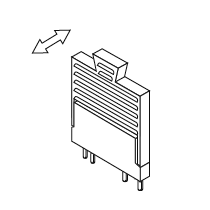 |
|
7.Wiring and circuit configuration
1. Perform wiring according to the internal schematic. Take care not to make any mistakes.
In particular, with the RT-3 Unit relay (PA-N relay type) and 4-point terminal, be careful of the polarity on the output side when equipped with AQZ10*D (DC type).
Also, with the RT-3 Unit relay (PhotoMOS Power type), be careful of the polarity on the output side of the DC type (RT3SP1-**V for type equipped with AQZ102).
2.We recommend the use of wire-pressed terminals for connection to the terminal portion.
●Example of applicable wire-pressed terminal
| Company Name |
Part Name |
Applicable wire-pressed terminal |
| J.S.T. Mfg Co., Ltd. |
1.25 to C3A |
0.25 to 1.65mm2 |
3.When the load is inductive, limit spike voltages generated from the load to less than the maximum load voltage. Typical circuits are shown below.
1.Add a clamp diode to the load. |
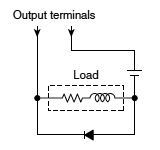 |
|
2.Add an R-C snubber to the load. |
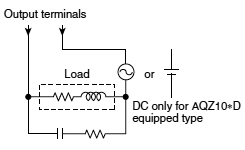 |
|
3.Add a varistor between the output terminals. |
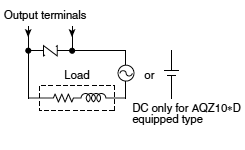 |
|
4.Even if spike voltages generated from the load are limited by a clamp diode or R-C snubber, inductances in long circuit wires will still create spike voltages.
Keep wires as short as possible to minimize inductance.
8.Installation
1.Perform mounting hole cutout according to the panel cutout drawings.
2.When installing the unit on a DIN rail, use the DIN rail locking lever on the side of the unit. Installation is accomplished by simply fitting the unit onto the rail and pressing gently.
3.To remove the unit from the DIN rail, use a flat head screwdriver to pull out the DIN rail locking lever.
9.Transporting and storage
1.If the product is subjected to extreme vibration while being transported, the relays may become detached, the lead may become bent, and the unit may become damaged. Handle the carton and case with care.
2.If the product is stored in an extremely adverse environment, visible defects and deterioration of performance characteristics may result. We recommend the following storage conditions.
- Temperature: 5 to 30°C
- Humidity: Max. 60% R.H.
- Environment: No hazardous substances such as sulfurous acid gases and little dust.
10.When equipped with PhotoMOS Power voltage drive type [RT-3 Unit relay (PA-N relay type), 4-point Terminal]
Since the PhotoMOS Power voltage sensitive type does not require the current-controlling resistance on the input side, it can be used together with PA-N relays on RT-3 unit relay (PA-N relay type).
When connecting PhotoMOS Power voltage sensitive types, since it will be a close connection, it will be necessary to be careful of load currents. Be sure to refer to the information given regarding “Load currents vs ambient temperature characteristics” in the precautions given for use of 4-point terminals.
Return to top
Return to top
 Business
> Industrial Devices
> Automation Controls Top
> Components & Devices
> Relays / Couplers
> /ac/e/control/relay/interface-terminal/index.jsp?c=search">Interface Terminal
> RT-3 UNIT RELAY (PA-N relay type) /4-POINT TERMINAL (Without relay type)
> Cautions For Use
Business
> Industrial Devices
> Automation Controls Top
> Components & Devices
> Relays / Couplers
> /ac/e/control/relay/interface-terminal/index.jsp?c=search">Interface Terminal
> RT-3 UNIT RELAY (PA-N relay type) /4-POINT TERMINAL (Without relay type)
> Cautions For Use










